- AAVE broke above a two-year price range and could be eyeing $200.
- AAVE has outperformed its credit sector rivals and the top DeFi blue chip tokens.
Aaf [AAVE] was an outlier on the price charts, defying the general market headwinds that derailed most assets at the start of the second half of 2024. It performed slightly better than even Bitcoin [BTC] on an annual basis (YTD).
BTC rose 42%, while AAVE’s YTD return was 46% at the time of writing.
Arthur Cheong, founder of crypto VC DeFiance Capital, projected the DeFi token would regain its ATH (all-time high) after a breakout in the range.
“$AAVE is trading at its highest level since May 2022 and appears to be breaking the two-year consolidation pattern. Expect the recovery of ATH to further strengthen the DeFi Renaissance.”
AAVE is optimistic about the prospects
For context, AAVE debuted in 2020 and reached an ATH of $668 at the peak of the previous cycle’s bull run in 2021. The recent breakout from the two-year price range could take the altcoin to $200 in the medium term.


Source: AAVE/USDT, TradingView
At the time of writing, the alt was valued at $158, suggesting a potential gain of 26% was likely if AAVE recovery was expanded to $200.
Despite the overbought conditions flashed by technical chart indicators, the DeFi renaissance mentioned by Cheong is on the rise.
A recent Bernstein report highlighted a resurgence in the DeFi market and falling US bank rates as a positive catalyst for DeFi interest demand.
The report highlighted AAVE’s strong growth potential and solid fundamentals, indicating the company is poised to benefit from likely demand.
Among credit industry peers, AAVE had the most active loans, with $7.35 billion, followed by Makers [MKR] Spark protocol.


Source: Token terminal
This was almost double the loan amount of around $3.4 billion at the beginning of 2024. This underlined the growth of the protocol, but its remarkable performance was also clearly visible in the price charts.
So far in the third quarter, AAVE is up 60% while the rest of the credit sector and overall DeFi blue chip tokens are in the red.
MKR and Uniswap [UNI] fell by 38% and 28% respectively. Lido [LDO] fell the most, with a decline of 44% in the same period.


Source: AAVE vs DeFi Tokens, TradingView
Interestingly, AAVE disconnected itself from the rest after its sell-off in early August. Messari research analyst Kinji Steimetz linked The better performance of AAVE over a recent protocol cost change proposal and reduced supply overhang.

